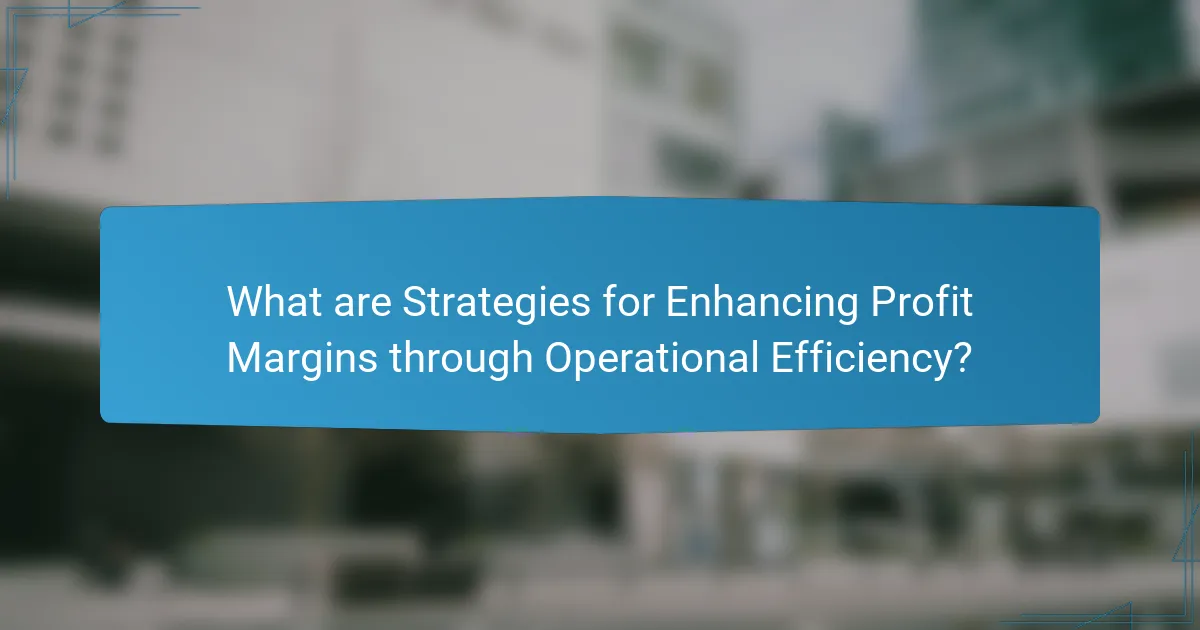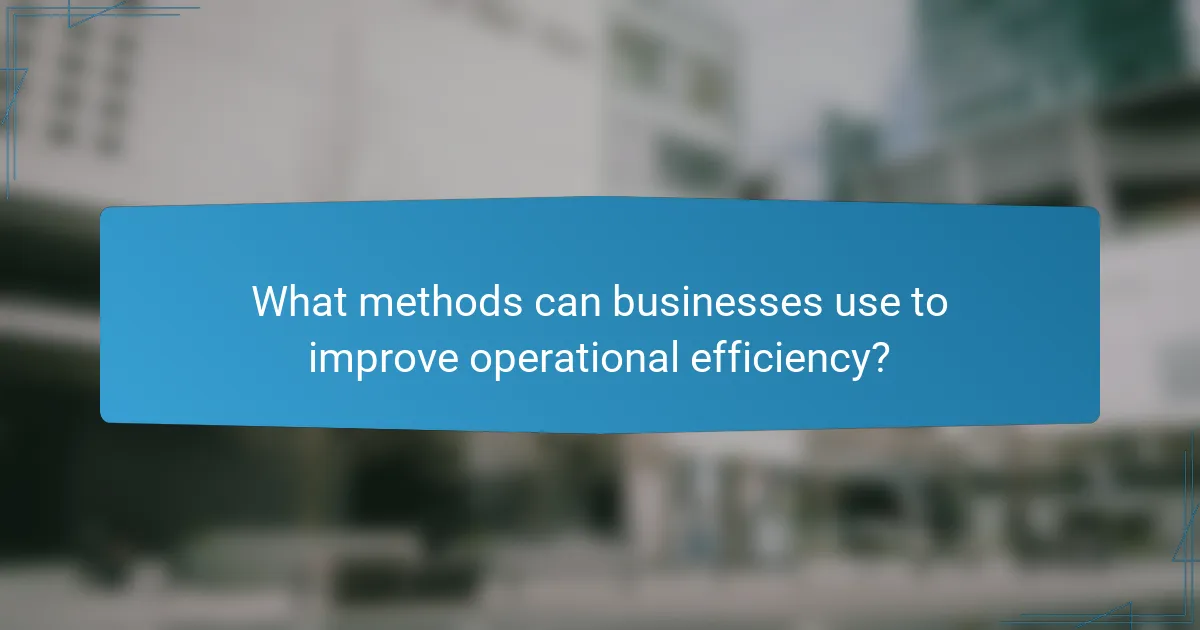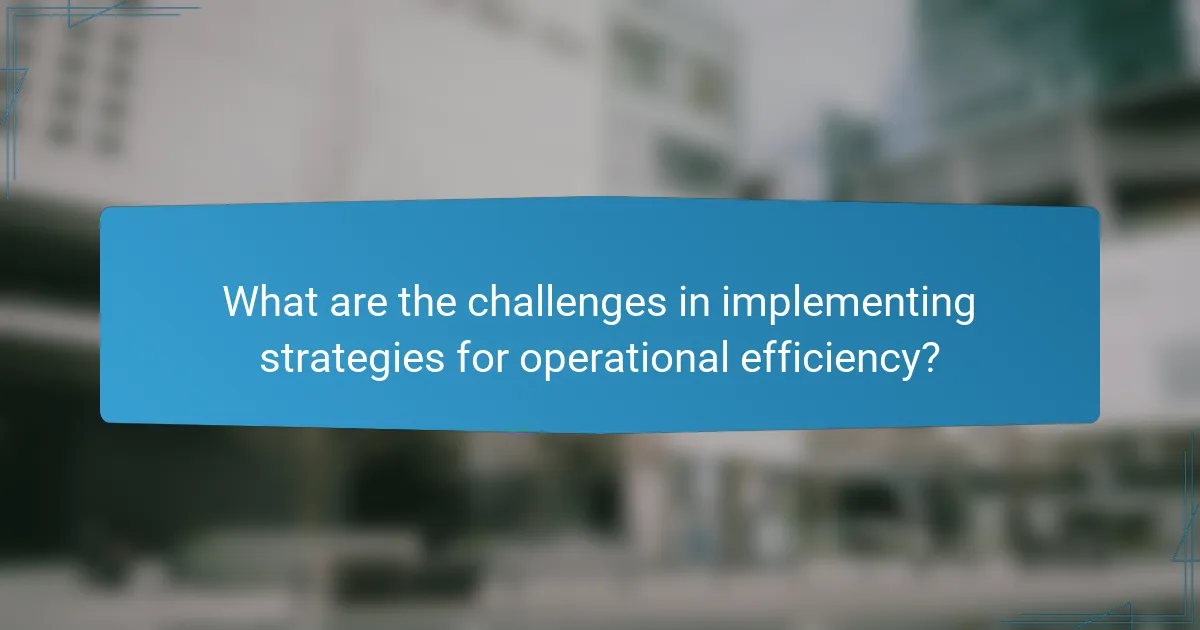The article focuses on strategies for enhancing profit margins through operational efficiency. Key strategies include streamlining processes to eliminate bottlenecks, reducing waste through lean management techniques, and optimizing resource allocation for effective use of labor, materials, and technology. Additionally, automation of repetitive tasks and employee training are highlighted as methods to improve productivity and reduce operational costs. The article also addresses challenges such as resistance to change, resource limitations, and inadequate training, emphasizing the need to overcome these barriers for successful implementation of efficiency strategies. Studies indicate that organizations prioritizing operational efficiency can achieve significant profit margin increases.

What are Strategies for Enhancing Profit Margins through Operational Efficiency?
Strategies for enhancing profit margins through operational efficiency include streamlining processes, reducing waste, and optimizing resource allocation. Streamlining processes involves identifying bottlenecks and eliminating unnecessary steps. Reducing waste can be achieved by implementing lean management techniques that focus on value creation. Optimizing resource allocation ensures that labor, materials, and technology are used effectively. Automation of repetitive tasks can also significantly increase efficiency. Companies that adopt these strategies often see improved productivity and lower operational costs. According to a study by McKinsey, organizations that focus on operational efficiency can increase profit margins by up to 20%.
How do operational efficiency strategies impact profit margins?
Operational efficiency strategies enhance profit margins by reducing costs and optimizing resource use. These strategies streamline processes, minimize waste, and improve productivity. For example, companies adopting lean manufacturing techniques have reported profit margin increases of 10-20%. Additionally, automating repetitive tasks can lead to significant labor cost savings. According to a study by McKinsey, organizations that implement operational efficiency measures can boost their profit margins by up to 25%. Effective inventory management also contributes by decreasing holding costs and improving cash flow. Overall, operational efficiency directly correlates with higher profit margins through cost reduction and improved operational performance.
What are the key components of operational efficiency?
The key components of operational efficiency include process optimization, resource management, and performance measurement. Process optimization involves streamlining workflows to reduce waste and increase productivity. Resource management ensures that human, financial, and physical resources are utilized effectively. Performance measurement tracks metrics to assess efficiency and identify areas for improvement. Together, these components create a cohesive strategy for enhancing overall efficiency. Studies show that companies implementing these components can see significant improvements in profit margins and operational performance.
How can operational efficiency lead to cost reduction?
Operational efficiency leads to cost reduction by optimizing resource use and minimizing waste. Efficient processes streamline operations, reducing time and labor costs. For example, companies that implement lean manufacturing techniques often see significant savings. A study by the Lean Enterprise Institute found that lean practices can reduce operational costs by 20% to 50%. Additionally, improved efficiency can enhance productivity, allowing businesses to produce more with the same resources. This increase in output further drives down per-unit costs. By focusing on operational efficiency, organizations can achieve sustainable cost savings over time.
Why are profit margins important for businesses?
Profit margins are crucial for businesses as they indicate the profitability of operations. A higher profit margin means a company retains more profit from each dollar of sales. This is essential for covering expenses, investing in growth, and ensuring long-term sustainability. Profit margins also provide insights into operational efficiency. For instance, companies with high profit margins often have effective cost control measures. According to the Small Business Administration, businesses with profit margins above 10% are generally considered healthy. Thus, monitoring profit margins helps businesses make informed financial decisions and strategic adjustments.
What factors influence profit margins?
Profit margins are influenced by various factors including cost structure, pricing strategy, and market competition. Cost structure refers to fixed and variable costs that directly impact profitability. For instance, higher production costs can reduce profit margins. Pricing strategy determines how much a company charges for its products or services. Competitive pricing can lead to lower margins if not managed effectively. Market competition affects demand and pricing power. In a saturated market, companies may need to lower prices, impacting profit margins. Additionally, operational efficiency plays a crucial role. Streamlined operations can reduce costs and improve margins. For example, companies that optimize supply chains often see better profit margins. Thus, understanding these factors is essential for enhancing profit margins.
How do operational efficiencies correlate with financial performance?
Operational efficiencies directly enhance financial performance. Efficient operations reduce costs and increase productivity. This leads to higher profit margins. A study by the Harvard Business Review found that companies with streamlined operations saw a 20% increase in profits. Additionally, operational efficiencies improve resource allocation. This results in better inventory management and reduced waste. Companies that adopt lean methodologies often report improved financial outcomes. For instance, Toyota’s lean practices have consistently led to superior financial results. Thus, there is a strong correlation between operational efficiencies and financial performance.

What methods can businesses use to improve operational efficiency?
Businesses can improve operational efficiency through automation, process optimization, and employee training. Automation reduces manual tasks and increases speed. For instance, using software for inventory management can cut down errors. Process optimization involves analyzing workflows to eliminate inefficiencies. Streamlining communication channels can enhance collaboration and reduce delays. Employee training equips staff with necessary skills, leading to better performance. According to a study by McKinsey, companies that invest in employee development see a 20% increase in productivity. Implementing these methods can lead to significant cost savings and improved profit margins.
How can technology enhance operational efficiency?
Technology enhances operational efficiency by automating processes and improving resource management. Automation reduces manual labor, which decreases errors and increases speed. For example, using software like ERP systems streamlines workflows across departments. Improved data analytics enables better decision-making by providing real-time insights. Cloud computing facilitates collaboration and accessibility, allowing teams to work efficiently from various locations. According to a McKinsey report, companies that adopt advanced technologies can increase productivity by up to 20-25%. These advancements lead to cost savings and enhanced profit margins.
What types of technology are most effective for improving efficiency?
Automation technology is most effective for improving efficiency. Automation streamlines repetitive tasks, reducing the time and labor required. For example, robotic process automation (RPA) can handle data entry tasks faster than human workers. Cloud computing enhances collaboration and access to resources, allowing teams to work simultaneously from different locations. Project management software improves task tracking and team communication, leading to better project outcomes. Data analytics tools provide insights that help organizations make informed decisions quickly. These technologies collectively contribute to increased productivity and reduced operational costs.
How do automation and data analytics contribute to operational improvements?
Automation and data analytics significantly enhance operational improvements by streamlining processes and providing actionable insights. Automation reduces manual tasks, allowing employees to focus on higher-value activities. This leads to increased productivity and efficiency. Data analytics identifies trends and patterns, enabling informed decision-making. Organizations can optimize resource allocation and minimize waste through these insights. According to a McKinsey report, companies using automation and analytics can improve productivity by up to 20-30%. This demonstrates the tangible benefits of integrating these technologies into operations.
What role does employee training play in operational efficiency?
Employee training significantly enhances operational efficiency. It equips employees with necessary skills and knowledge. Well-trained staff perform tasks more effectively. This reduces errors and increases productivity. According to a study by the Association for Talent Development, companies that invest in training see a 24% higher profit margin. Training also fosters employee engagement and retention. Engaged employees are more likely to contribute to process improvements. Overall, effective training directly correlates with improved operational performance.
How can training programs be designed to enhance efficiency?
Training programs can be designed to enhance efficiency by incorporating targeted skill development. Focused training aligns employee capabilities with organizational goals. This approach ensures that staff are equipped with relevant skills. Regular assessments can identify areas needing improvement. Incorporating feedback loops allows for continuous program refinement. Utilizing technology can streamline training delivery and tracking. Evidence shows that companies with structured training see productivity gains of up to 20%. Ultimately, well-designed training programs lead to improved operational efficiency and profit margins.
What are the long-term benefits of investing in employee training?
Investing in employee training leads to significant long-term benefits. These benefits include increased employee productivity and improved job satisfaction. Trained employees are more skilled and efficient in their roles. This efficiency can result in higher quality output and reduced errors. Additionally, training fosters employee loyalty and reduces turnover rates. According to a study by the Association for Talent Development, organizations that invest in training experience 24% higher profit margins. Furthermore, ongoing training helps companies adapt to industry changes and innovations. This adaptability positions businesses to remain competitive in the market. Overall, the long-term benefits of employee training contribute to enhanced operational efficiency and profitability.

What are the challenges in implementing strategies for operational efficiency?
Challenges in implementing strategies for operational efficiency include resistance to change, lack of resources, and inadequate training. Resistance often stems from employees fearing job loss or increased workloads. Limited resources can hinder the adoption of new technologies or processes. Inadequate training may lead to improper implementation of efficiency strategies. Additionally, misalignment between departmental goals can create conflicts. A study by the Harvard Business Review found that 70% of change initiatives fail, often due to these challenges. This data underscores the importance of addressing these barriers for successful operational efficiency.
What common obstacles do businesses face?
Businesses commonly face obstacles such as cash flow issues, competition, and regulatory compliance. Cash flow problems can hinder operations and growth. According to a 2021 QuickBooks survey, 61% of small businesses experience cash flow challenges. Competition requires businesses to differentiate themselves to maintain market share. Regulatory compliance can impose significant costs and complexities, impacting operational efficiency. A report from the National Federation of Independent Business highlights that 30% of small businesses struggle with regulations. Additionally, staffing challenges and technology adoption can impede progress. These obstacles collectively affect profitability and operational efficiency.
How can resistance to change be managed within an organization?
Resistance to change can be managed within an organization by implementing effective communication strategies. Clear communication helps employees understand the reasons for change. It also addresses their concerns and reduces uncertainty. Involving employees in the change process fosters a sense of ownership. This can increase their commitment to new initiatives. Training programs can equip employees with the necessary skills for adapting to change. Providing support throughout the transition period is crucial. Research shows that organizations that prioritize employee engagement experience lower resistance levels. For example, a study by Kotter International indicates that effective change management can lead to a 70% success rate in transformation initiatives.
What strategies can mitigate risks associated with operational changes?
Implementing a structured change management process can mitigate risks associated with operational changes. This process involves thorough planning, stakeholder engagement, and clear communication. Conducting a risk assessment before changes ensures potential issues are identified early. Training employees on new procedures reduces resistance and increases adoption. Regularly monitoring the implementation allows for timely adjustments. Establishing feedback mechanisms helps address concerns and improve processes. Utilizing data analytics can identify trends and predict potential challenges. These strategies collectively enhance operational efficiency and protect profit margins.
How can businesses measure the success of operational efficiency strategies?
Businesses can measure the success of operational efficiency strategies through key performance indicators (KPIs). These KPIs include metrics such as cost reduction, productivity improvements, and time savings. Monitoring these metrics provides insights into the effectiveness of implemented strategies. For example, a 10% reduction in operational costs can indicate successful efficiency measures. Additionally, tracking employee output can reveal productivity gains. Customer satisfaction scores can also reflect the impact of efficiency on service delivery. An increase in these scores often correlates with improved operational processes. Regular analysis of these KPIs allows businesses to adjust strategies as needed. This approach ensures continuous improvement and alignment with operational goals.
What key performance indicators (KPIs) should be tracked?
Key performance indicators (KPIs) that should be tracked include gross profit margin, net profit margin, and operating efficiency ratio. Gross profit margin measures the percentage of revenue exceeding the cost of goods sold. Net profit margin indicates the overall profitability after all expenses. Operating efficiency ratio assesses the relationship between operating expenses and revenue. Tracking these KPIs helps businesses identify areas for improvement. For instance, a gross profit margin above 50% is often considered healthy in many industries. Monitoring these indicators can lead to informed decision-making and enhanced operational efficiency.
How can feedback loops improve ongoing efficiency efforts?
Feedback loops can significantly enhance ongoing efficiency efforts by facilitating continuous improvement. They allow organizations to gather data on performance metrics and identify areas for enhancement. For instance, real-time feedback from employees can reveal inefficiencies in processes. This data enables teams to make informed adjustments quickly. Additionally, feedback loops create a culture of accountability. Employees feel empowered to contribute to efficiency initiatives. Research shows that companies with effective feedback mechanisms report higher productivity levels. A study by the Harvard Business Review found that organizations with strong feedback cultures see a 14.9% increase in employee engagement. This engagement translates to improved operational efficiency and profit margins.
What are best practices for enhancing profit margins through operational efficiency?
Best practices for enhancing profit margins through operational efficiency include streamlining processes, reducing waste, and leveraging technology. Streamlining processes involves analyzing workflows to identify bottlenecks. This can lead to faster production times and lower labor costs. Reducing waste focuses on minimizing excess materials and optimizing resource use. Implementing lean manufacturing principles can support this goal. Leveraging technology, such as automation and data analytics, enhances decision-making and operational speed. According to a McKinsey report, companies that adopt advanced analytics can increase their profitability by 5-10%. Regularly reviewing and adjusting operational strategies ensures sustained efficiency and profitability.
What actionable steps can businesses take to implement these strategies?
Businesses can implement strategies for enhancing profit margins through operational efficiency by conducting a thorough process analysis. This involves mapping out current workflows to identify bottlenecks and inefficiencies. After identifying these areas, businesses should prioritize improvements based on potential impact and cost.
Next, investing in technology that automates repetitive tasks can streamline operations. Research indicates that automation can reduce operational costs by up to 30%. Training employees on new systems is crucial for successful implementation.
Additionally, businesses should establish key performance indicators (KPIs) to measure effectiveness. Regularly reviewing these KPIs allows for ongoing adjustments and improvements. Engaging employees in the process fosters a culture of continuous improvement.
Finally, soliciting feedback from both employees and customers can provide insights into further enhancements. According to a study by McKinsey, organizations that prioritize employee engagement see a 21% increase in profitability.
How can continuous improvement be fostered within an organization?
Continuous improvement can be fostered within an organization by implementing a culture of feedback and innovation. Encouraging employee involvement in decision-making enhances ownership and accountability. Regular training sessions can equip staff with new skills and methodologies. Utilizing data-driven metrics helps track progress and identify areas for enhancement. Establishing clear goals aligns team efforts towards common objectives. Recognizing and rewarding contributions motivates ongoing participation in improvement initiatives. Engaging in regular review cycles allows for the assessment of processes and practices. According to a study by the Harvard Business Review, organizations that embrace continuous improvement see significant gains in efficiency and profitability.
Strategies for enhancing profit margins through operational efficiency focus on optimizing processes, reducing waste, and effective resource management. Key components include automation, employee training, and performance measurement, which collectively drive productivity and cost savings. The article discusses the impact of operational efficiency on profit margins, highlighting the correlation between streamlined operations and improved financial performance. It also addresses challenges in implementation and best practices for fostering continuous improvement within organizations. Overall, the content provides actionable insights for businesses aiming to boost profitability through operational efficiency.